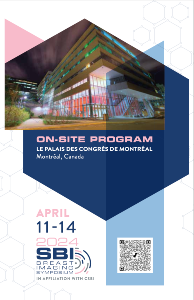Pre-Course Schedule
Pre-Course Schedule
- Cancelled
-
A Stroll Outside or Within the Reading Room? Improving Wellness through Reading Room Design and Flexible Scheduling Options
-
A workforce movement survey of breast radiologists: why leave now?
-
An AI-guided expert review process can lower radiologist recall rates
-
Association Between Breast Arterial Calcifications and Increased Cardiovascular Risk: Clinical Implications and Role in Preventative Care
-
Atypical Ductal Hyperplasia: A Single Center Analysis of Imaging Features Associated with Decreased Risk of Malignancy Upgrade at Time of Excision.
-
Basics of Payment Policy for the Breast Imager
-
Benign and malignant vascular lesions of the breast: a multimodal imaging and pathology review
-
Breast Arterial Calcifications: Getting the Most Out of Your Mammogram
-
Breast findings on somatostatin receptor PET/CT: a spectrum of benign and malignant diagnoses
-
Breast Imaging in 2034: Artificial Intelligence’s Impact on the Fight Against Breast Cancer
-
Case-based Primer on Estrogen Receptor-Targeting PET/CT for Imaging Breast Cancer: Application, Protocol and Interpretation
-
Categorical AI decreases interval cancer rate in a large-scale deployment
-
Comparison of Bleeding Events Following Image-Guided Axillary Biopsy in Patients Temporarily Discontinuing Versus Continuing Antithrombotic Therapy
-
Comparison of Malignant discordant rates and high risk discordant rates between Ultrasound, Stereotactic and MRI guided core needle biopsies:
-
Contrast Enhanced Mammography for Surveillance of Recurrence after Breast Conserving Surgery
-
Contrast Enhanced Mammography Lexicon- A Pictorial Review
-
Contrast Enhanced Mammography versus Breast MRI for pre- operative assessment of pathologically proven breast malignancies: A case series from a large regional tertiary cancer center experience.
-
Contrast-Enhanced Mammography after Cryoablation of Breast Cancer: A Novel Role for Detection of Residual or Recurrent Tumor
-
Cryoablation Therapy for Breast Cancer: The “What, Why and How”
-
Deep Learning Translates Imaging Biomarkers to Detect DCIS vs Invasive Breast Cancer, Surpassing Traditional Risk Assessment Methods
-
Defining efficacy in palliative breast cancer cryoablation: Beyond the ICE3 trial
-
Diagnostic Performance of Imaging for Breast Cancer during Pregnancy and Lactation: Systematic Review
-
Diffuse Unilateral Breast Findings on Breast MRI
-
Enhancing Inclusivity and Communication for non-English-speaking Patients in Breast Imaging
-
Enhancing Quality and Safety Protocols in Breast MRI: A Radiology Department's Initiative
-
Exploring the Nipple-Areolar Complex: Anatomy, Radiology, Pathology, and Treatment
-
ICAP Flaps Unveiled: A Breast Radiologist's Guide to Multimodality Imaging of a Novel Breast Reconstruction Option
-
Idiopathic Granulomatous Mastitis: Case Series and Pictorial Essay
-
Imaging Management of Newly-Diagnosed Breast Cancer in Pregnant Patients: Maternal-Fetal Considerations
-
Impact of a unique AI-based tool for interpretative and non-interpretative applications in breast imaging
-
Implementation of a novel approach to breast cancer risk assessment in the breast imaging setting
-
Improved Cancer Detection Rate with AI Support in Prospective Interpretation of Screening Digital Breast Tomosynthesis Exams
-
Inflammatory and infectious diseases of the breast: diagnosis and intervention
-
Initial Clinical Experience with Contrast Enhanced Digital Breast Tomosynthesis (CEDBT)
-
Keep Calm and Biopsy On: 6 Steps to Making Breast Biopsies More Comfortable
-
Lateral Arm DBT Approach: Easy, Effective and Efficient Wireless Preoperative Localization
-
Lessons Learned from Discordant Breast Biopsies
-
Look out for Lymphoma: The Rare Entity you should suspect
-
Male Breast Lymphoma
-
Metastasis to the breast a diagnostic challenge
-
Mobile Mammography: Outcomes One Year Later
-
Multidisciplinary Collaboration in Breast Imaging: Implementing Radiology-Pathology Conferences to Improve Management of High-Risk Lesions.
-
My Patient Has Dense Breast Tissue… Now What? Empowering Radiologists to Guide Patient-specific Recommendations for Supplemental Screening
-
Optimizing Diagnostic Breast Imaging: A Cost-Effective Approach to BI-RADS 3 Surveillance
-
Optimizing Patient Experience for Women with Disabilities in The Breast Imaging Clinic
-
Performance of an Artificial Intelligence System on Screening Digital Breast Tomosynthesis Cases in Various Ethnic Groups
-
Polymastia: More than Just a Benign Accessory in the Axilla
-
Racial Disparities in Mammography Screening Utilization Under Draft USPSTF Guidelines
-
Rare breast tumors and uncommon histological subtypes
-
Reducing Errors and Liability: Insights from Missed and Near-Missed Breast Cancer Cases
-
Right in the Nick of Time: Wireless Single Step MRI localization of Breast Lesions using Radar Reflectors
-
Road to Building an Early Career Education Curriculum: Evaluating Pilot Webinar Series Success
-
Role of the radiologist in the preoperative evaluation of the Deep Inferior Epigastric Perforator (DIEP) flap in breast cancer patient
-
SAVI Scout localization using MRI guidance: initial experience
-
Seeing Beyond Grayscale: Biopsy Marker Detection Made Simpler with Vendor-Agnostic Doppler Twinkling for Breast Imagers and Surgeons
-
Seeing is believing: How accurately does MRI measure residual disease following neoadjuvant treatment in TNBC?
-
Sentinel Lymph Node Superparamagnetic Iron Oxide (SPIO) and Its Impact on Subsequent Breast Cancer Detection
-
Telemammography, Breast Imaging’s Savior or Demise: Experiences from the nation’s largest remote mammography program
-
The Allergic Breast Imaging Patient: What to do when they arrive in your department.
-
The First Clue: Understanding Appropriate Use of Initial Method of Detection (MOD) in Breast Imaging
-
The many faces of fat necrosis: A multimodal review and tips to differentiate fat necrosis from new or recurrent malignancy.
-
To Benign or Not to Benign: Review of Benign Breast Skin Masses
-
To Implant or Not To Implant: A Case Series on the Rare Breast Implant-Associated Anaplastic Large Cell Lymphoma
-
Training Tomorrow’s Mentors: Results from the Society of Breast Imaging’s Mentorship Training Pilot Program
-
Trends in Axillary Lymph Node Biopsies Before and After the COVID-19 Vaccine Era
-
Understanding Invasive Lobular Carcinoma (ILC) to Prevent False Negatives (FN)
-
What’s That Cystic Mass? A Pictorial Review of Complex Cystic and Solid Masses with Pathologic Correlation

